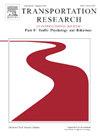What psychological and socio-demographic factors can influence people’s intention to use ridesharing during the war? A case study in Ukraine
IF 3.5
2区 工程技术
Q1 PSYCHOLOGY, APPLIED
Transportation Research Part F-Traffic Psychology and Behaviour
Pub Date : 2025-02-01
DOI:10.1016/j.trf.2024.12.014
引用次数: 0
Abstract
Public transport services can be disrupted by natural or human-made crises, such as the recent war in Ukraine. Ridesharing has the potential to be used as an alternative to public transport during such crises. However, peoples’ attitudes and intentions towards ridesharing during war has not been studied. This study aims to address this critical gap by collecting and analysing travel behaviour data in two Ukrainian cities: Kyiv and Odessa. Exploratory factor analysis identified ten factors influencing ridesharing, namely: attitudes, perceived behavioural control, subjective norm, ease of use, usefulness, moral norms, trust, perceived safety, emotions, and discrimination. Then, a combined conceptual model based on the Theory of Planned Behaviour, and the Technology Acceptance Model was proposed, to incorporate potential psychological and socio-demographic in the context of a war situation. Structural equation modelling was used to explore the causal relationships between these factors and ridesharing. In the context of war, perceived ‘usefulness’ affected attitudes, while perceived ‘ease of use’ influenced perceived behavioural control. Moral norms strongly impacted the ridesharing intention; trust influenced attitudes; and gender played a major role by indirectly affecting ridesharing intention. This can provide transport planners and policy-makers with insights as to how ridesharing can be more attractive and become a genuine tool for enhancing human mobility resilience.
在战争期间,哪些心理和社会人口因素会影响人们使用拼车服务的意愿?以乌克兰为例
公共交通服务可能会因自然或人为危机而中断,比如最近的乌克兰战争。在这样的危机中,拼车有可能被用作公共交通的替代品。然而,战争期间人们对拼车的态度和意图并没有被研究过。本研究旨在通过收集和分析乌克兰两个城市(基辅和敖德萨)的旅行行为数据来解决这一关键差距。探索性因素分析确定了影响拼车的十个因素,即:态度、感知行为控制、主观规范、易用性、实用性、道德规范、信任、感知安全、情绪和歧视。然后,提出了一个基于计划行为理论和技术接受模型的组合概念模型,以将潜在的心理和社会人口统计学纳入战争形势的背景下。使用结构方程模型来探索这些因素与拼车之间的因果关系。在战争背景下,感知到的“有用性”影响态度,而感知到的“易用性”影响感知到的行为控制。道德规范强烈影响拼车意愿;信任影响态度;性别通过间接影响拼车意愿发挥了重要作用。这可以为交通规划者和政策制定者提供见解,让他们了解如何使拼车更具吸引力,并成为增强人类出行弹性的真正工具。
本文章由计算机程序翻译,如有差异,请以英文原文为准。
求助全文
约1分钟内获得全文
求助全文
来源期刊
CiteScore
7.60
自引率
14.60%
发文量
239
审稿时长
71 days
期刊介绍:
Transportation Research Part F: Traffic Psychology and Behaviour focuses on the behavioural and psychological aspects of traffic and transport. The aim of the journal is to enhance theory development, improve the quality of empirical studies and to stimulate the application of research findings in practice. TRF provides a focus and a means of communication for the considerable amount of research activities that are now being carried out in this field. The journal provides a forum for transportation researchers, psychologists, ergonomists, engineers and policy-makers with an interest in traffic and transport psychology.

 求助内容:
求助内容: 应助结果提醒方式:
应助结果提醒方式:


